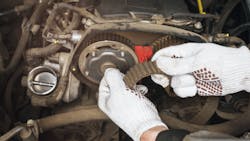In my first autonomous maintenance assignment in the 1970s, my engineer boss told me if I saw any problems, especially if something was unusually hot, I should come and get him. He never defined what a “problem” was nor did he give me any way to determine what was “hot.”
The problem was that I was an inexperienced oiler aboard the converted T2 Tanker, with only four weeks of service aboard any vessel at that point. And this ship was quite old, a Korean War relic, in fact. Every component looked messed up and radiated heat. To me, they all teetered on the edge of failure. Bothering the engineer didn’t seem practical every 15 minutes.
I was ignorant. I did not know what I was looking at and didn’t even know what it did. My 18-year-old mind’s solution was to concentrate on more important things, such as my tan (when I had free time).
It was okay to show me how to grease something, but not okay to ask me to inspect it, especially if missing something led to dire consequences. Ultimate responsibility for any potential catastrophic failures would rest with the engineer, but the experience would have also ruined my taste for maintenance in general.
Do we have the same problem in the bay with preventive maintenance? We might, if the technician inspecting a unit or system does not have the sufficient training and experience to know what they are looking at.
Recently, I took my car into the dealer for some work. They came back with a $2,000-$3,000 quote to replace the engine mounts. I was suspicious because the car was relatively new (but out of warranty). I took the car to my long-time trusted mechanic for a second opinion. After an inspection by the experienced technician, he explained that while he could see their perspective, he could also see where a miniscule oil leak was dripping on the engine mount and that was an easier fix.
Another problem area is dealing with your typical fleet check sheet. Check sheets don’t help. The reason is that they are designed for industry veterans with decades of experience. They are “implicit tasking,” where the detailed knowledge is in the inspector’s brain. A bit more explicit direction would be more impactful for typical mechanics.
Task list check sheet activities include:
- Checking the belts
- Checking the connection
- Checking operation
These are widespread and useful tasks on a PM task list, but in too many cases don’t get the job done.
This is because it takes the person performing the PM many months or even years to see each and every failure mode of the various belts, connections, and assets overall that are brought in. But we often ask someone with an unknown experience level to inspect for something they may or may not have seen before.
This can be an easy fix simply by adjusting the verbiage. I suggest everyone review their task lists for qualifiers that even an untrained eye can spot:
- Check belt tension
- Check belts for cracks, chewed-up edges, etc.
- Check the connection for tightness by loosening the nut and retightening hand-tight
- Check the connection for corrosion (visually). If corroded, disassemble, remove corrosion
- Check for smooth operation, note unusual noises, vibrations, etc.
These qualifiers help to direct inspectors to specific, actionable things, reminding the inspector of the common failure modes. You might even ask the senior techs what they look for (listen for, feel for, smell, etc.). Of course, a nearby picture book with photographs of failure modes would also make for an excellent visual aid. With smart phones being everywhere, encourage everyone to photograph any unusual wear, deterioration, defect, damage, and of course, failure modes. Accumulate these photographs in an album for everyone to review (especially the newbies).
The main goal is to get technicians to “look” for problems, not just “see” if they can find one, as my first boss had advised. And despite what the dictionary says, looking and seeing aren’t the same.
See: To perceive with the eyes; look at.
Look: To ascertain using one’s eyes.
If you go back to their origins in Old English, you can notice where they differ.
See: Old English seon “to see, look, behold; observe, perceive, understand; experience, visit, inspect.”
Look: Old English locian “use the eyes for seeing, gaze, behold, spy.”
So, in truth, we want the inspector to do both: See—observe, perceive, understand—the equipment; as well as know what to look for (gaze, behold, spy).
In essence, we ought to start teaching the art of seeing. Or, more specifically, the art of seeing with one’s mind open. Ask questions like, “Does anything look out of place, or look ‘bad?’” A few more include: What would cause that condition? Will this lead to failure (and how severe)? How could we avoid this problem?
Being able to see develops slowly. Anything you can do to speed it up will pay dividends in avoided failures and more stable operation.
Joel Levitt is the president of Springfield Resources, a management consulting firm that services a variety of clients on a wide range of maintenance issues. Levitt has trained more than 17,000 maintenance leaders from more than 3,000 organizations in 38 countries. He is also the creator of Laser-Focused Training, a flexible training program that provides specific, targeted training on your schedule, online to one to 250 people in maintenance management, asset management, and reliability.
About the Author

Joel Levitt
President, Springfield Resources
Joel Levitt has trained more than 17,000 maintenance leaders from more than 3,000 organizations in 24 countries. He is the president of Springfield Resources, a management consulting firm that services a variety of clients on a wide range of maintenance issues www.maintenancetraining.com. He is also the designer of Laser-Focused Training, a flexible training program that provides specific targeted training on your schedule, online to one to 250 people in maintenance management, asset management and reliability.
